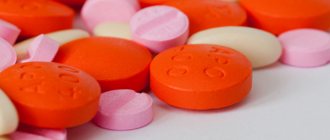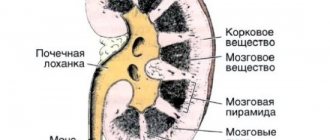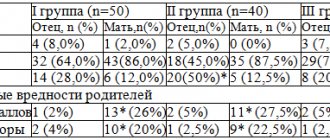Features of the development and course of urinary tract infection in patients with diabetes mellitus
| Sergey Anatolyevich Dubsky Candidate of Medical Sciences, urologist of the Department of Andrology and Urology of the Federal State Institution “Endocrinological Research Center” of the Ministry of Health and Social Development [email protected] |
| Alexander Evgenievich Lepetukhin Candidate of Medical Sciences, urologist of the Department of Andrology and Urology of the Federal State Institution “Endocrinological Research Center” of the Ministry of Health and Social Development [email protected] |
Impaired carbohydrate metabolism has a negative impact on almost all organs and systems of the human body, including the genitourinary system.
Among the main urological complications in diabetes mellitus (DM), urinary tract infections (UTIs) are the most common. One of the specific processes in diabetes is an increase in the concentration of glucose in the urine against the background of hyperglycemia, which serves as a risk factor for damage to the urothelium and its serous-mucoid layer. The main pathogenetic factors causing the development of UTIs and inflammatory diseases of the genitourinary system in diabetes are:
- toxic and dysmetabolic effects of hyperglycemia;
- micro- and macroangiopathies that contribute to ischemia of the tissues of the genitourinary system;
- specific polyneuropathy, leading to neurogenic dysfunction of the muscle layer with further development of urine retention;
- reduced phagocytic activity of leukocytes and bactericidal urine against the background of hyperglucosuria.
In type 1 diabetes, the above factors include a long course of diabetes, the onset of diabetes before and during puberty with the early (after 5-10 years) development of peripheral and autonomic neuropathy.
An important factor in protecting the macroorganism from infection is the level of sex hormones, in particular: the level of estrogen and progesterone for women and testosterone for men. Various studies have shown the presence of a large number of estrogen receptors in the urethra. The formation of a serous-mucoid layer on the surface of the urothelium is considered a hormonal-dependent process: estrogens affect the synthesis of mucopolysaccharides, and progesterone affects their release by epithelial cells. The positive role of testosterone in influencing urothelial receptors is also confirmed.
Features of diagnosis and treatment of acute and chronic inflammatory kidney diseases in patients with diabetes
Long-term decompensation of carbohydrate metabolism is a risk factor for the development and progression of an acute infectious inflammatory process in the kidneys, but pyelonephritis itself is not a complication of diabetes. It has been established that patients with diabetes are especially vulnerable to the rapid progression of infection in the renal parenchyma and its subsequent complications. In turn, acute pyelonephritis (AP) and chronic inflammation in the kidneys are factors that aggravate the course of such a formidable specific complication as diabetic nephropathy. The tendency to catabolic processes and a distinct decrease in microcirculation worsen the course of purulent infection in the kidneys.
An additional factor that aggravates the development of AP and the progression of chronic pyelonephritis is endothelial dysfunction, which, against the background of prolonged exposure to hyperglycemia, leads to impaired angiogenesis and hemostasis. The direct glucotoxic effect leads to a decrease in NO synthesis and an increase in the concentration of endothelin-1 in the renal vessels, which as a result causes their constriction, platelet aggregation, and mono-platelet adhesion.
The use of Doppler ultrasound (US) and multislice computed tomography (MSCT) in the diagnosis of AP allows one to assess the depth and degree of destruction, differentiate diffuse from focal damage, and also record the spread of the inflammatory process into the retroperitoneal area. Doppler examination in the diagnosis of AP provides information about the structural and functional state of blood flow in the kidneys and the elasto-tonic properties of blood vessels. Thus, ultrasound and Doppler examination of the kidneys in case of decompensated diabetes can be performed up to 2 times a day. Performing MSCT with contrast requires the mandatory use of only low-osmolar solutions, sufficient hydration and monitoring of renal function (blood creatinine level) over the next 3 days to exclude contrast-induced nephropathy.
The prescription of antibacterial therapy to patients with diabetes and AP should be carried out simultaneously with the stabilization of glycemia, the level of which should be brought closer to the expected individual target values. Patients with type 2 diabetes in severe cases of AP, who are on diet therapy or taking oral hypoglycemic drugs, should be immediately transferred to insulin therapy and subsequently, until the situation is resolved, treated as surgical patients.
Antibacterial therapy for AP with preserved or restored urine passage should begin without delay. According to the recommendations of the European Association of Urology (2010) for the treatment of UTIs, in patients with complicated pyelonephritis, therapy with fluoroquinolones, aminopenicillins with β-lactamase inhibitors, II-III generation cephalosporins (for example, Suprax - an oral III generation cephalosporin), carbopenems and aminoglycosides is recommended. However, it is known that the use of aminoglycosides in patients with diabetes, due to their severe nephrotoxicity, is possible only in exceptional cases and under careful monitoring of renal function.
According to the opinion of domestic and foreign experts, AP should be considered as an acute surgical disease, in which, in cases of development of a purulent process, patients are subject to surgical intervention. At the same time, there are reports in the literature that in some cases, even purulent forms of AP in patients with diabetes can be successfully treated with conservative methods provided that timely diagnosis, preserved urine passage and early initiation of therapy. Upon further observation of this group of patients who received conservative therapy for AP, according to radiological studies, no areas of nephrosclerosis were noted.
The most commonly identified causative agent of UTI in both patients with and without diabetes is E. coli. Enterobacteriaceae and Klebsiella can also often cause infection. Although the main causative agents of pyelonephritis in diabetes are bacteria, fungi also play a certain role. With the development of pyelonephritis against the background of diabetes, there is a high risk of developing candidiasis of the urinary system with a predominance of Candida alb. The pathogenic properties of Candida alb, which cause damage to various organs, including the urinary tract, appear only with a significant weakening of the immunological defense.
When treating candidiasis infection in patients with diabetes, the following features must be taken into account:
- an antifungal drug with the lowest level of side effects is preferred (fluconazole Mikosist); it inhibits the activity of enzymes, thereby increasing the permeability of the cell membrane and disrupting the growth and reproduction of fungi;
- with a long-term chronic course of the disease and, as a rule, a sluggish process, a long-term treatment regimen is required;
- After the main course of treatment, the patient must remain registered at the dispensary.
Lower urinary tract and genital infections
Men with diabetes on the background of specific polyneuropathy may have an asymptomatic course of chronic prostatitis. As a result, examination by a urologist is necessary annually or in the event of an unexplained deterioration in glycemic control. If there is an increased number of leukocytes in the prostate secretion in patients with diabetes, even in the absence of symptoms of inflammation, it is necessary to study the sterility of the prostate secretion and determine antibiotic sensitivity. The main criterion for the diagnosis and results of treatment of patients with chronic prostatitis should be the dynamics of symptoms and laboratory parameters, which in turn should be assessed together with compensation of carbohydrate metabolism.
An important role in the development of lower urinary tract infections (LUTI) in women with diabetes is played by detrusor hypoxia and urothelial damage, which intensify against the background of prolonged decompensation of carbohydrate metabolism. Estrogen deficiency is also of great importance, which in turn can form against the background of chronic hyperglycemia. Estrogen deficiency additionally leads to apoptosis of smooth muscle fibers, damage to conductive nerve fibers, ultrastructural changes in the detrusor, urothelium, and serous-mucoid protective surface layer. That is why, in addition to standard urological examinations if a UTI is suspected, it is necessary to conduct a diagnostic search for a possible deficiency of sex hormones. Prescribing hormone replacement therapy in patients with diabetes and impaired estrogen levels has a positive result.
Asymptomatic bacteriuria (AB) is a common condition in men and women with diabetes. In studies of AB, more than 105 CFU/ml in women and men with diabetes is detected in 9.0-27% and 0.7-11% of cases, respectively. In 70% of women with diabetes and AB, leukocyturia is detected. According to foreign studies, pyuria due to AB does not require antibiotic therapy. It has also been proven that AB in patients with diabetes is not an indication for antibiotic therapy.
Therapy for UTI in patients with diabetes is carried out according to the same principles as in patients without diabetes, and includes the use of antibacterial, antimycotic, anti-inflammatory drugs, and the result mainly depends on the level of glycemia at the time of the development of the pathological process and the degree of compensation of carbohydrate metabolism from the onset SD. The drugs of choice are fluoroquinolones, aminopenicillins with P-lactamase inhibitors, II-III generation cephalosporins (for example, Suprax).
Diabetic autonomic neuropathy of the bladder
One of the important risk factors for the development of UTI in patients with diabetes is autonomic diabetic neuropathy with damage to the bladder - diabetic cystopathy (DC). DC is characterized by a disturbance in the sensation of filling the bladder, and with the progression of pathological processes - a decrease in detrusor contractility, up to the development of chronic urinary retention.
Today, ideas about the pathogenesis of the development of autonomic neuropathy of the bladder in diabetes are similar to the development of autonomic polyneuropathy of other organs and systems, but recently much attention has been paid to damage to the endoneurial blood flow. There are no exact data on the prevalence of DC in the world literature. The difficulty of studying this problem is associated with an asymptomatic onset, a long course, as well as a lack of accurate routine diagnostic methods.
Currently, there are no standards for the diagnosis and treatment of diabetic autonomic neuropathy. Prevention of this condition is based on the general principles of managing patients with diabetes - long-term, stable compensation of diabetes with the prevention of the development of micro and macroangiopathies. Diagnostic measures for urinary disorders in patients with diabetes are well known:
- general clinical urine analysis;
- determination of residual urine volume;
- uroflowmetry.
Additional, clarifying studies may include:
- complex urodynamic study (pressure/flow study with electromyography, registration of urethral pressure profile);
- urethrocystoscopy.
To date, no treatment method has been proposed that would be reliably effective in the treatment of autonomic diabetic polyneuropathy, in the structure of which DC develops.
The most commonly recommended drug for the treatment of diabetic neuropathy is α-lipoic (thioctic) acid, a phosphodiesterase type 5 blocker. However, these drugs can only be effective in the early stages of polyneuropathy development. DC can be complicated by the development of bladder outlet obstruction, for the correction of which α1-blockers (for example, Sonizin) are used, but when they are used against the background of already existing autonomic neuropathy, retrograde ejaculation can develop in men. In case of severe DC, it is recommended to attempt to urinate every 2-4 hours, regardless of the presence of the urge to urinate, and/or resolve the issue of intermittent autocatheterization.
Thus, in order to prevent infectious and inflammatory kidney diseases, screening for UTIs in diabetes should be carried out annually. Particular attention should be paid to the study of etiopathogenetic mechanisms of the development of infectious inflammatory diseases of the genitourinary organs and urinary tract in patients with diabetes, with the development of new preventive and treatment algorithms, which will certainly not only prolong the life of a patient with diabetes, but also significantly improve its quality.
0
Your rating: No
What is asymptomatic leukocyturia?
This is a condition in which the patient does not report the presence of UTI symptoms, but a complete urinalysis shows the presence of white blood cells in the urine. When urine is cultured, the culprits of the infection also grow in large numbers. 27% of diabetic patients have asymptomatic leukocyturia.
Studies have shown that asymptomatic bacteriuria does not reduce the risk of developing diabetic nephropathy in well-controlled diabetes mellitus. However, treatment for this condition is not recommended, since the use of antibacterial drugs leads to increased resistance of bacteria to treatment. This may lead to the development of more severe UTIs in the future.
Instrumental diagnostic methods
Ultrasound examination (ultrasound) in patients with pyelonephritis can reveal characteristic changes in the structure of the renal tissue: expansion of the renal pelvis, coarsening of the contour of the calyces, heterogeneity of the parenchyma with areas of scarring (with a long history of the disease). In addition, ultrasound is a valuable method for diagnosing conditions that cause pyelonephritis or support its chronic course - hydronephrosis due to a neurogenic bladder, urolithiasis, polycystic kidney disease. X-ray methods in the diagnosis of pyelonephritis are currently relegated to second place due to the danger of radiation exposure and the need to administer radiocontrast agents, which is unsafe in patients with diabetes. Computed tomography of the kidneys does not have significant advantages over ultrasound; it is used to differentiate from tumor processes. Radionuclide diagnostic methods are used to determine the mass of functioning parenchyma, which has prognostic significance.
Treatment
The first step in treating polyneuropathy is to maintain blood glucose within the target range agreed upon by your doctor and reduce high blood pressure and cholesterol levels.
Managing your glucose levels will minimize the risk of diabetic neuropathy. A key part of treatment is reducing pain and eliminating some symptoms.
Certain medications and physical therapy can help control the pain of diabetic neuropathy, along with other treatments. However, they cannot restore nerve cells. Patients should also stop smoking and limit alcohol consumption to a maximum of one drink per day for women and two for men.
Types
Peripheral neuropathy can cause loss of sensation in the legs.
There are four main types of neuropathy:
- Peripheral symmetric neuropathy : affects the feet and hands. This is the most common form of diabetic neuropathy.
- Autonomic neuropathy : develops in nerve fibers that control involuntary body functions, such as digestion, urination, or heart rate.
- Proximal neuropathy : affects the nerves, roots, plexuses of a certain part of the spine
- Mononeuropathy : any nerve is affected .
Symptoms of neuropathy depend on the type and nerve affected.
Medications
There are a number of medications that can help cope with pain:
- anticonvulsants
- tricyclic antidepressants
- opioids and non-opioid pain medications
Opioid use can lead to addiction, so doctors should prescribe them in the smallest dose possible
Physical therapy, used in combination with medication, can help relieve pain and reduce the risk of opioid addiction.
A chiropractor, massage therapist, or osteopath may provide regular massages or manual therapy to stretch muscles. Massage can suppress muscle contractions, cramps and atrophy due to poor blood supply.
Specific exercises, such as swimming or aerobics, can help a person develop and maintain muscle strength and reduce muscle loss.
Therapeutic ultrasound is another type of physical therapy that uses ultrasound waves to stimulate the tissue under the skin. This may help some people regain feeling in their legs.








